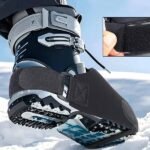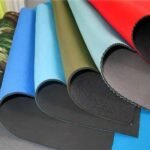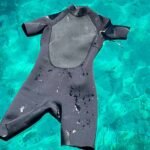Have you ever found yourself out in the wild, enjoying a day of fishing or hunting, only to discover a tear or hole in your neoprene waders? It’s frustrating when your gear fails you at the worst possible moment. As someone who spends countless hours in the great outdoors, I understand the importance of keeping your neoprene waders in top condition. Patching them properly can extend their lifespan and ensure you stay dry and comfortable.
Properly patching neoprene waders is essential for maintaining their functionality and extending their usability during outdoor adventures.
I remember a chilly morning on the river when a small tear in my waders almost ruined the day. With a quick patch, I was back to fishing without missing a beat. This experience taught me the value of knowing how to effectively repair neoprene waders.
What Are Neoprene Waders and Why Are They Important?
Neoprene waders are waterproof garments made from neoprene, a synthetic rubber material known for its flexibility and insulation properties. These waders are essential for activities like fishing, hunting, and other outdoor pursuits that require staying dry in wet environments. They protect you from cold water, mud, and other elements, ensuring comfort and safety during extended periods in the water.
Neoprene waders are crucial for outdoor enthusiasts as they provide both waterproofing and insulation, allowing for prolonged activities in wet and cold conditions.
I’ve spent countless hours in my neoprene waders, whether navigating swift rivers or standing still in icy waters. Their ability to keep me dry and warm has made them indispensable for my outdoor adventures, highlighting their importance in ensuring both comfort and performance.
Insulation and Warmth
| Feature | Description |
|---|---|
| Thermal Insulation | Keeps your body warm in cold water, preventing hypothermia. |
| Flexible Material | Allows for a wide range of motion without restricting movement. |
| Lightweight | Easy to carry and wear for long periods without fatigue. |
Durability and Protection
- Abrasion Resistance: Neoprene is highly resistant to wear and tear, making waders durable even in rough environments.
- Chemical Resistance: Protects against exposure to various chemicals and pollutants commonly found in natural water bodies.
- UV Protection: Some neoprene waders come with UV-resistant properties, preventing degradation from prolonged sun exposure.
Neoprene waders offer a combination of warmth, flexibility, and durability that makes them ideal for various outdoor activities. Their robust construction ensures they can withstand harsh conditions, providing reliable protection and comfort.
Which Types of Damage Require Patching on Neoprene Waders?
Neoprene waders, while durable, can still suffer from various types of damage that compromise their effectiveness. Common damages that require patching include tears, punctures, and seam splits. These issues can lead to leaks, reducing the waders’ ability to keep you dry and warm. Addressing these damages promptly is essential to maintain the integrity and functionality of your waders.
Identifying and addressing tears, punctures, and seam splits in neoprene waders is crucial for preventing leaks and ensuring long-term durability.
I once noticed a small tear in my waders during a fishing trip. Ignoring it initially led to increased discomfort as water seeped in, making the day less enjoyable. Patching the tear immediately restored the waders’ performance, reinforcing the importance of timely repairs.
Tears and Rips
- Causes: Abrasion against rocks, branches, or other sharp objects in the water.
- Impact: Direct entry points for water, leading to leaks and decreased insulation.
Punctures and Holes
- Causes: Accidental punctures from fishing hooks, debris, or other sharp items.
- Impact: Similar to tears, punctures allow water to enter, making it essential to patch them quickly.
Seam Splits
- Causes: Overuse, material fatigue, or improper handling.
- Impact: Can create large gaps along the seams, significantly compromising the waders’ waterproofing.
Understanding the different types of damage helps in determining the appropriate patching method and materials needed to effectively repair your neoprene waders.
Can You Patch a Hole in Neoprene Waders?
Yes, you can patch a hole in neoprene waders. Patching is a straightforward process that can restore the waterproof integrity of your waders. It involves cleaning the damaged area, applying a suitable adhesive, and placing a patch over the hole. Properly patched waders can perform as well as new ones, providing a cost-effective solution to extend their lifespan.
Patching a hole in neoprene waders is a feasible DIY task that can effectively restore their waterproof properties and extend their usability.
I successfully patched a small puncture in my waders using a neoprene patch kit. The repair held up well during my subsequent fishing trips, proving that with the right materials and techniques, you can maintain your waders without needing to replace them.
Dive Deeper: Step-by-Step Patching Process
Preparing the Damaged Area
- Clean the Area: Use mild soap and water to clean the damaged area thoroughly. Remove any dirt, debris, or oils that could prevent the adhesive from bonding properly.
- Dry Completely: Allow the area to dry completely to ensure the patch adheres effectively.
Applying the Patch
- Cut the Patch: Cut a neoprene patch that is at least an inch larger than the hole on all sides. This ensures full coverage and prevents further tearing.
- Apply Adhesive: Use a neoprene-specific adhesive to apply a thin, even layer to both the patch and the damaged area.
- Position the Patch: Carefully place the patch over the hole, pressing firmly to eliminate any air bubbles and ensure a strong bond.
- Cure Time: Allow the adhesive to cure as per the manufacturer’s instructions, usually for several hours, before using the waders again.
Final Inspection
- Check for Leaks: After curing, inspect the patch to ensure it is watertight. Submerge the patched area in water to test for any leaks.
- Reinforce if Necessary: If leaks are detected, apply additional adhesive and patches as needed.
By following these steps, you can effectively patch holes in your neoprene waders, restoring their functionality and ensuring they remain a reliable part of your outdoor gear.
What is the Best Glue to Fix Neoprene Waders?
Selecting the right glue is crucial for effectively repairing neoprene waders. The best glue for this purpose is a neoprene-specific adhesive, such as Seam Grip by Gear Aid or 3M Neoprene Adhesive. These adhesives are designed to bond neoprene materials securely, providing a waterproof and flexible seal that can withstand the rigors of outdoor use.
Using a neoprene-specific adhesive ensures a strong, waterproof bond that maintains the flexibility and durability of the patched area.
I’ve experimented with various adhesives over the years, and neoprene-specific glues consistently provide the best results. They form a reliable bond that holds up well against water exposure and movement, making them the preferred choice for patching waders.
Seam Grip by Gear Aid
- Features: Flexible, waterproof, and designed specifically for neoprene repairs.
- Advantages: Easy to apply, dries clear, and remains flexible after curing.
- Usage: Ideal for small to medium-sized patches on waders and other neoprene gear.
3M Neoprene Adhesive
- Features: High-strength bonding, resistant to water and temperature changes.
- Advantages: Durable bond, suitable for both indoor and outdoor repairs.
- Usage: Best for larger patches and areas subjected to significant stress.
Plasti Dip
- Features: Rubberized coating that adheres well to neoprene.
- Advantages: Provides a waterproof seal and adds a protective layer to the patch.
- Usage: Useful for reinforcing the patch and adding extra durability.
Contact Cement
- Features: Strong adhesive with quick bonding properties.
- Advantages: Creates a durable and immediate bond between neoprene surfaces.
- Usage: Suitable for large patches or areas requiring extra strength.
Best Practices for Using Adhesives
- Follow Instructions: Always follow the manufacturer’s instructions for application and curing times.
- Ventilation: Use adhesives in a well-ventilated area to avoid inhaling fumes.
- Test First: Test the adhesive on a small, inconspicuous area of the wader to ensure compatibility and effectiveness.
- Apply Evenly: Ensure an even application of glue to prevent gaps or weak spots in the patch.
Choosing the right adhesive is essential for a successful repair. Neoprene-specific adhesives provide the best results, ensuring your patched waders remain waterproof and durable for many more adventures.
How Do You Fix a Hole in Neoprene?
Fixing a hole in neoprene involves a few essential steps to ensure the repair is watertight and durable. The process includes cleaning the area, applying adhesive, placing a patch, and allowing it to cure properly. By following these steps, you can effectively mend holes in your neoprene gear, restoring its functionality and extending its lifespan.
Fixing a hole in neoprene requires careful preparation, the right materials, and precise application to ensure a lasting and waterproof repair.
I once had to repair a large tear in my wetsuit after an accidental snag on a rocky shore. Following a meticulous repair process, I was able to restore the wetsuit’s integrity, allowing me to continue my water activities without further issues.
Materials Needed
- Neoprene patch material
- Neoprene-specific adhesive
- Scissors
- Ruler or measuring tape
- Marker or pen
- Cleaning cloth or sponge
Step-by-Step Repair Guide
-
Assess the Damage
- Determine the size and location of the hole to choose an appropriate patch size.
- Inspect the surrounding area for additional wear or stress points.
-
Clean the Area
- Use a mild soap and water solution to clean the damaged area thoroughly.
- Remove any dirt, oils, or debris that could interfere with the adhesive bond.
- Allow the area to dry completely before proceeding.
-
Prepare the Patch
- Cut a neoprene patch that extends at least an inch beyond the hole on all sides.
- Round the corners of the patch to prevent peeling and ensure a better seal.
-
Apply Adhesive
- Apply a thin, even layer of neoprene-specific adhesive to both the patch and the damaged area.
- Be careful to cover the entire patch surface for a secure bond.
-
Place the Patch
- Carefully position the patch over the hole, ensuring it is centered and aligned correctly.
- Press firmly to eliminate any air bubbles and ensure full contact between the patch and the wader.
-
Secure the Patch
- Use weights or clamps to hold the patch in place while the adhesive cures.
- Follow the adhesive manufacturer’s instructions regarding curing time, typically several hours to overnight.
-
Inspect the Repair
- After curing, check the patch for any gaps or weak spots.
- Test the repair by submerging the area in water to ensure it is watertight.
-
Reinforce if Necessary
- If leaks are detected, apply additional adhesive and patches as needed.
- Consider using a second patch for extra durability on larger repairs.
Tips for a Successful Repair
- Work in a Clean Environment: Ensure your workspace is clean to prevent contamination of the adhesive.
- Use the Right Patch Material: Neoprene patches are essential for compatibility and durability.
- Avoid Stretching: Keep the patch area as flat as possible to ensure an even bond without stretching the neoprene.
- Allow Adequate Curing Time: Rushing the curing process can result in a weaker bond and potential leaks.
By meticulously following these steps, you can effectively fix holes in neoprene, ensuring your gear remains functional and reliable for your outdoor adventures.
How to Ensure the Patch on Neoprene Waders Is Waterproof and Durable?
Ensuring that the patch on your neoprene waders is both waterproof and durable involves using the right materials, proper application techniques, and thorough curing. Attention to detail during the repair process will result in a patch that can withstand water exposure and the physical demands of outdoor activities, providing a long-lasting solution to your waders’ damage.
Achieving a waterproof and durable patch on neoprene waders requires meticulous application of the appropriate materials and adherence to proper repair techniques.
I once repaired a seam split on my waders, ensuring the patch was waterproof by applying multiple layers of adhesive and reinforcing the area with an additional patch. This double reinforcement proved essential during a day of fishing in rough waters, where the patched area remained intact and leak-free.
Selecting the Right Patch Material
- Neoprene Sheets: Use high-quality neoprene sheets that match the thickness and flexibility of your waders.
- Pre-cut Patches: Consider using pre-cut neoprene patches designed for specific repair needs, ensuring optimal fit and coverage.
Proper Adhesive Application
- Even Coverage: Apply the adhesive evenly to both the patch and the wader to prevent weak spots.
- Multiple Layers: For larger repairs, applying multiple layers of adhesive can enhance the bond’s strength and durability.
- Heat Treatment: Some adhesives require heat to activate the bonding process. Follow the manufacturer’s instructions for best results.
Reinforcement Techniques
- Double Patching: Apply a second patch over the first for added strength, especially in high-stress areas.
- Seam Reinforcement: Use additional adhesive along the edges of the patch to reinforce the seam and prevent peeling.
- Overlap Method: Ensure the patch overlaps sufficiently with the wader’s surface to distribute stress and reduce the likelihood of future tears.
Curing and Testing
- Adequate Curing Time: Allow the adhesive to cure fully as per the instructions, avoiding use of the waders until the repair is completely set.
- Water Testing: Submerge the patched area in water to test for leaks, ensuring the patch is fully waterproof before regular use.
- Drying and Inspection: After testing, let the patch dry and inspect for any signs of weakness or incomplete bonding.
Maintenance and Care
- Regular Inspection: Periodically check the patched areas for signs of wear or new damage, addressing issues promptly.
- Proper Storage: Store your waders in a cool, dry place away from direct sunlight to prevent degradation of the neoprene material.
- Gentle Handling: Avoid excessive stretching or rough handling of the patched areas to maintain the integrity of the repair.
Advanced Reinforcement Options
- Seam Sealing Tape: Apply neoprene-specific seam sealing tape over the patch for an additional layer of protection against water ingress.
- Industrial Adhesives: For professional-grade repairs, consider using industrial-grade neoprene adhesives that offer superior bonding strength and waterproofing.
By implementing these techniques, you can ensure that the patch on your neoprene waders remains both waterproof and durable, providing reliable protection and extending the life of your gear.
Conclusion
In conclusion, patching neoprene waders is a practical and effective way to extend the life of your essential outdoor gear. By understanding the different types of damage, selecting the right materials, and following proper repair techniques, you can ensure that your waders remain waterproof and durable, allowing you to enjoy your water activities without interruption.
At Szoneier, we specialize in providing high-quality neoprene products, including waders, bags, gloves, wetsuits, and more. With our 20 advanced production lines, we ensure that each product meets stringent quality standards while offering customizable options to suit your specific needs. Our products are durable, finely textured, soft, highly elastic, shock-resistant, thermally insulating, waterproof, and available in various designs, colors, sizes, and packaging options. We cater to B2B, wholesale, OEM, and ODM models, primarily exporting to Europe, North America, and Australia.
Whether you are a brand owner, wholesaler, importer, or design firm, Szoneier is equipped to provide you with reliable and high-quality neoprene products that meet your requirements. Our low minimum order quantities and flexible customization options make it easy for you to get started. Additionally, we offer free samples and color cards to help you make informed decisions.











